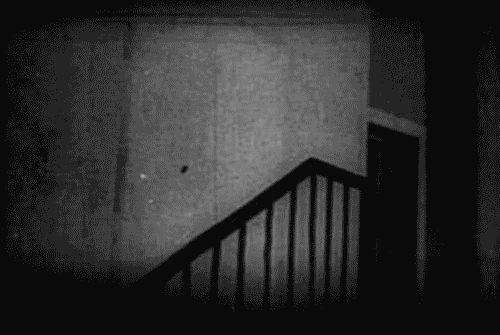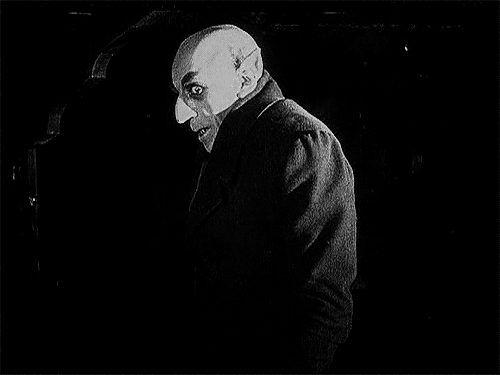I never saw Nosferatu, but I had heard many things about it. Prior to watching the film, I was aware that it was an old black-and-white silent film and that it was one of the first classic films that featured the vampire. And before I continue any further, let me just say that I was at least pretty creeped out from watching this film. After all, it was 1 a.m. in the morning and I was alone in a dark room.

Maybe it was the wind whistling in the silence. Or the wide-eyed facial expression of Count Orlok. Or the iconic creepy shadow of a deformed figure ascending the stairs. Or the extremely slow, yet incredibly ominous walk Orlok makes before he kills. But whatever it was, watching the film gave me the chills and it was NOT because my windows were open.

What’s refreshing about this film is that it does not rely on frightening or sudden sound effects to get the audience scared – or any sound for that matter. I think that its most effective quality is its silence. We may think that ominous music makes a movie scary, but in reality, silence can be even scarier because without sound, there isn’t any sense of reality to cling on to. Everything becomes muted – silent. You become immersed in a world in which you aren’t familiar with. And the quiet, dark room you’re sitting in starts to become a little too quiet…
.gif)
The content of the movie itself isn’t that scary. However, Count Orlok left a sizable impression on me because of his ghoulish appearance. His menacing eyes would always stare deep inside me. His claws would always reach out towards me. And his lack of expression left me to think there was no inkling of humanity left in him…

Horror isn’t the sudden jolts you get when something pops up in front of you. It isn’t the bloody gore that leaves a mark of disgust on your face. It’s really your overactive imagination that makes you afraid to look behind your back. It’s the dreadful feeling you get when you’re about to look into a mirror and become afraid of seeing something you don’t want to see. It’s all the “what-if” questions you start to ask yourself…
Horror is what happens after the movie.


I really love the way you described your emotions and thoughts of the film. I’m definitely on the same boat as you about watching it at 1:00 am. I literally felt like my own life at that moment was a silent movie!
I’m also quite happy that you think it was somewhat scary. Obviously for our time period, this doesn’t even come close to what we know as “horror”, but it does portray the timeless classic feeling to what horror was known as. Anyone who says that this movie didn’t leave some kind of an impression on them, regarding scariness, is a liar! Count Orlock is one heck of a creepy dude.
Your concluding line, “horror is what happens after the movie”, is eye opening, creative, and so true! I believe a movie can only be titled a horror film if audiences are still afraid after the movie after its closing credits. With this being said, horror becomes relative to the individual viewers. You consider Noseferatu a horror film, whereas I consider it a funny attempt at a horror film.
In your mood diary you talk about how the silence of the movie contributed to the fear you felt, however, I do not recall such moments of silence during the film. Instead, I remember the unnecessary joyful music and odd moments throughout the film that were supposed to be filled with scary music but were not. Perhaps the 1920s held a different standard of what was considered “scary” and what music contributed to this scary standard. Whatever the case, the 1920s and I have entirely different definitions of horror films…and I am glad you are/were able to find and appreciate the horrifying beauty of Noseferatu.
I agree with your idea that silence can sometimes be even scarier than an array of musical chords playing in the background. Without being pushed toward an overdone plot, silence gives your mind the dangerous freedom to imagine what might happen. Thus, each person conjures the scenario scariest for them. Many directors play off this exact idea. The rising action is often sufficiently built to the apex of the film until he or she vaguely depicts the climax. This allows fans to develop a range of interesting theories and interpretations as opposed to openly showing all the secrets of the plot.
I also enjoyed your definition of what horror means to you. To me, horror is more intense than scary. Being scared is a cheap thrill you can find at a haunted house or when your sibling scares you from behind a bedroom door. Horror is a deeper feeling that conflicts with a central value in your belief system. So, being horrified at a vampire isn’t because you find him repulsive and predatory, but it’s because seeing that vampire internally conflicts with your idea of the supernatural. I think our views of horror are different but similar to a certain degree. When you say, “It’s all the what-if questions,” that points me to my argument that horror approaches an internal conflict.
It does not take too much movie elements to make a horror movie successful, the surroundings of the viewers also greatly affect the scary effects of horror movies. I agree with you how this movie uses different strategies than the “jump scare” commonly used in horror films today to create scary effects. Of course, with numerous modern horror movies forming our basis, the contents of Nosferatu failed to impress me. But, the appearance of Orlok put a shine in my eyes as well. It’s hard to imagine how much effort they put into creating his appearance in a time when special effects aren’t that developed yet.